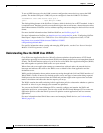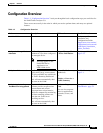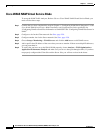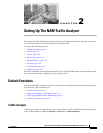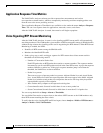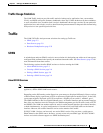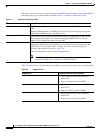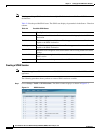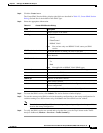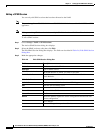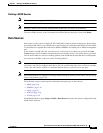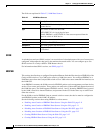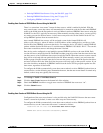
2-4
User Guide for the Cisco Network Analysis Module (NAM) Traffic Analyzer, 5.0
OL-22617-01
Chapter 2 Setting Up The NAM Traffic Analyzer
Traffic
Before you can monitor data, you must direct specific traffic flowing through a switch to the NAM for
monitoring purposes. Use the methods described in
Table 2-1, Methods of Directing Traffic.
Table 2-2, SPAN Sources, describes the types of SPAN sources and the possible ways to configure them.
Ta ble 2-1 Methods of Directing Traffic
Method Usage Notes
Switch SPAN
You can direct a set of physical ports, a set of VLANs, or a set of EtherChannels to the
NAM.
Selecting an EtherChannel as a SPAN source is the same as selecting all physical ports
comprising the EtherChannel as the SPAN source.
Switch Remote SPAN (RSPAN)
You can monitor packet streams from remote switches, assuming that all traffic from a
remote switch arrives at the local switch on a designated RSPAN VLAN. Use the
RSPAN VLAN as the SPAN source for the NAM.
NetFlow Data Export (NDE)
You can monitor NDE records directly from remote switches or routers. You must
configure the NDE source to the NAM from a local switch or remote router, using the
switch CLI. For received NDE traffic, a default site will be created including all
interfaces from that device. See
Sites, page 2-58.
SPAN and NDE sources can be in effect simultaneously.
Note Starting with NAM release 5.0, in addition to being a consumer of NDE
records, the NAM is also a producer of NDE data packets.
Ta ble 2-2 SPAN Sources
SPAN Source Configured with one of the following:
Any set of physical ports
• NAM Traffic Analyzer (the NAM GUI)
• Switch CLI
• Supervisor portCopyTable (SNMP)
Any EtherChannel
• NAM Traffic Analyzer (the NAM GUI)
• Switch CLI
• Supervisor portCopyTable (SNMP)
Any set of VLANs configured on the local switch
• NAM Traffic Analyzer (the NAM GUI)
• Switch CLI
• Supervisor portCopyTable (SNMP)



